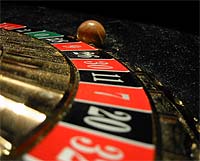5.3 - Mutual Independence
5.3 - Mutual IndependenceExample 5-6

Consider a roulette wheel that has 36 numbers colored red (\(R\)) or black (\(B\)) according to the following pattern:
| 1 | 2 | 3 | 4 | 5 | 6 | 7 | 8 | 9 | 10 | 11 | 12 | 13 | 14 | 15 | 16 | 17 | 18 |
| R | R | R | R | R | B | B | B | B | R | R | R | R | B | B | B | B | B |
| 36 | 35 | 34 | 33 | 32 | 31 | 30 | 29 | 28 | 27 | 26 | 25 | 24 | 23 | 22 | 21 | 20 | 19 |
and define the following three events:
- Let \(A\) be the event that a spin of the wheel yields a RED number = \(\{1, 2, 3, 4, 5, 10, 11, 12, 13, 24, 25, 26, 27, 32, 33, 34, 35, 36\}\).
- Let \(B\) be the event that a spin of the wheel yields an EVEN number = \(\{2, 4, 6, 8, 10, 12, 14, 16, 18, 20, 22, 24, 26, 28, 30, 32, 34, 36\}\).
- Let \(C\) be the event that a spin of the wheel yields a number no greater than 18 = \(\{1, 2, 3, 4, 5, 6, 7, 8, 9, 10, 11, 12, 13, 14, 15, 16, 17, 18\}\).
Now consider the following two questions:
- Are the events \(A\), \(B\), and \(C\) "pairwise independent?" That is, is event \(A\) independent of event \(B\); event \(A\) independent of event \(C\); and \(B\) independent of event \(C\)?
- Does \(P(A\cap B\cap C)=P(A)\times P(B)\times P(C)\)?
Let's take a look:
So... this example illustrates that something seems to be lacking for the complete independence of events \(A, B, \text{ and }C\). And, that's why the second condition exists in the following definition.
- Mutually Independent Event
-
Three events \(A, B,\text{ and }C\) are mutually independent if and only if the following two conditions hold:
- The events are pairwise independent. That is,
- \(P(A\cap B)=P(A)\times P(B)\) and...
- \(P(A\cap C)=P(A)\times P(C)\) and...
- \(P(B\cap C)=P(B)\times P(C)\)
- \(P(A\cap B\cap C)=P(A)\times P(B)\times P(C)\)
- The events are pairwise independent. That is,
The idea of mutual independence can be extended to four or more events — each pair, triple, quartet, and so on, must satisfy the above type of multiplication rule.
Example 5-7
One ball is drawn randomly from a bowl containing four balls numbered 1, 2, 3, and 4. Define the following three events:
- Let \(A\) be the event that a 1 or 2 is drawn. That is, \(A=\{1, 2\}\).
- Let \(B\) be the event that a 1 or 3 is drawn. That is, \(B = \{1, 3\}\).
- Let \(C\) be the event that a 1 or 4 is drawn. That is, \(C = \{1, 4\}\).
Are events \(A, B,\text{ and }C\) pairwise independent? Are they mutually independent?
This example illustrates, as does the previous example, that pairwise independence among three events does not necessarily imply that the three events are mutually independent.
Example 5-8
A pair of fair six-sided dice is tossed once yielding the following sample space:
\(S=\left\{\begin{array}{l}{(1,1)(1,2)(1,3)(1,4)(1,5)(1,6)} \\ {(2,1)(2,2)(2,3)(2,4)(2,5)(2,6)} \\ {(3,1)(3,2)(3,3)(3,4)(3,5)(3,6)} \\ {(4,1)(4,2)(4,3)(4,4)(4,5)(4,6)} \\ {(5,1)(5,2)(5,3)(5,4)(5,5)(5,6)} \\ {(6,1)(6,2)(6,3)(6,4)(6,5)(6,6)}\end{array}\right.\)
Define the following three events:
- Let \(A\) be the event that the first die is a 1, 2, or 3.
- Let \(B\) be the event that the first die is a 3, 4, or 5.
- Let \(C\) be the event that the sum of the two faces equals 9. That is \(C = \{(3,6), (6,3), (4,5), (5,4)\}\).
Are events \(A, B,\text{ and }C\) pairwise independent? Are they mutually independent?
In solving that problem, I admit to being a little loosey-goosey with the definition of "mutual independence." That's why I said "a sort of mutual independence." Now that I haven't been perfectly clear so far, let me set the record straight by being perfectly clear. This example illustrates that the second condition of mutual independence among the three events \(A, B,\text{ and }C\) (that is, the probability of the intersection of the three events equals the probabilities of the individual events multiplied together) does not necessarily imply that the first condition of mutual independence holds (that is, three events \(A, B,\text{ and }C\) are pairwise independent). In order to check for mutual independence, you clearly need to check both the first and second conditions.